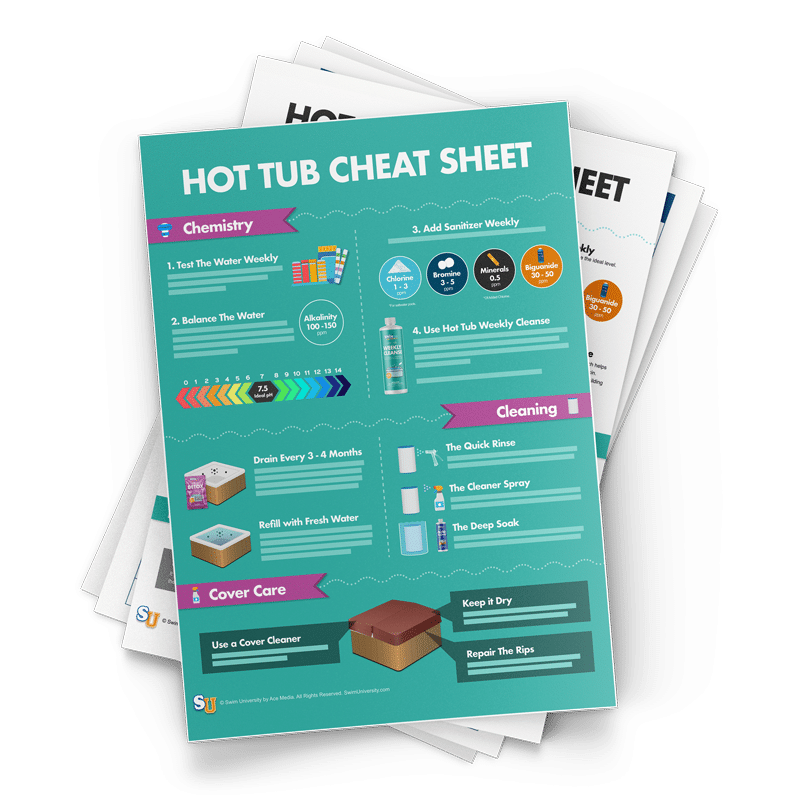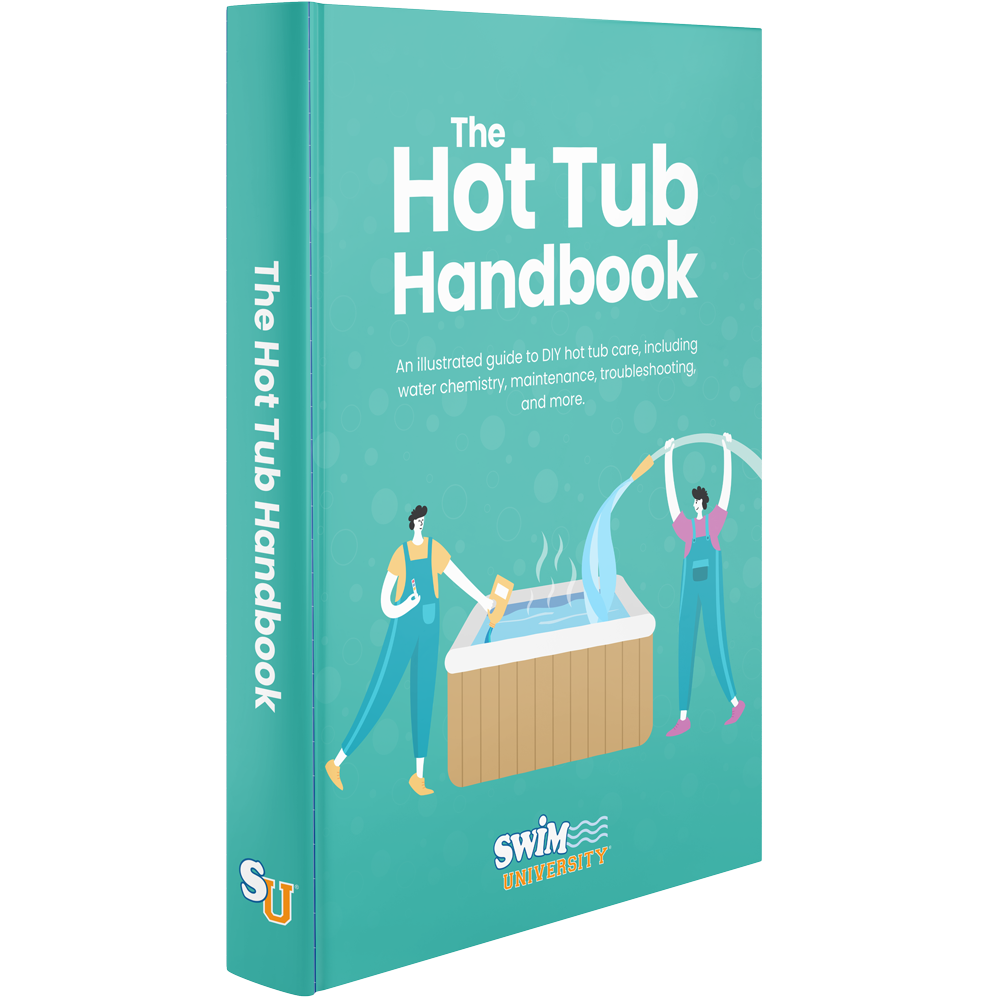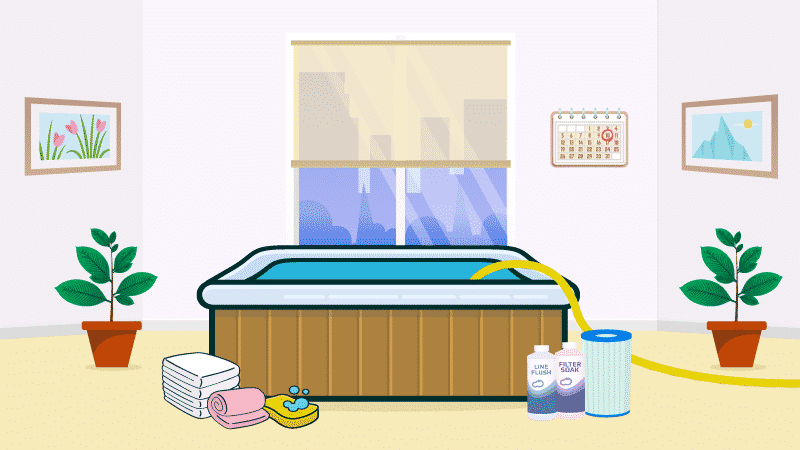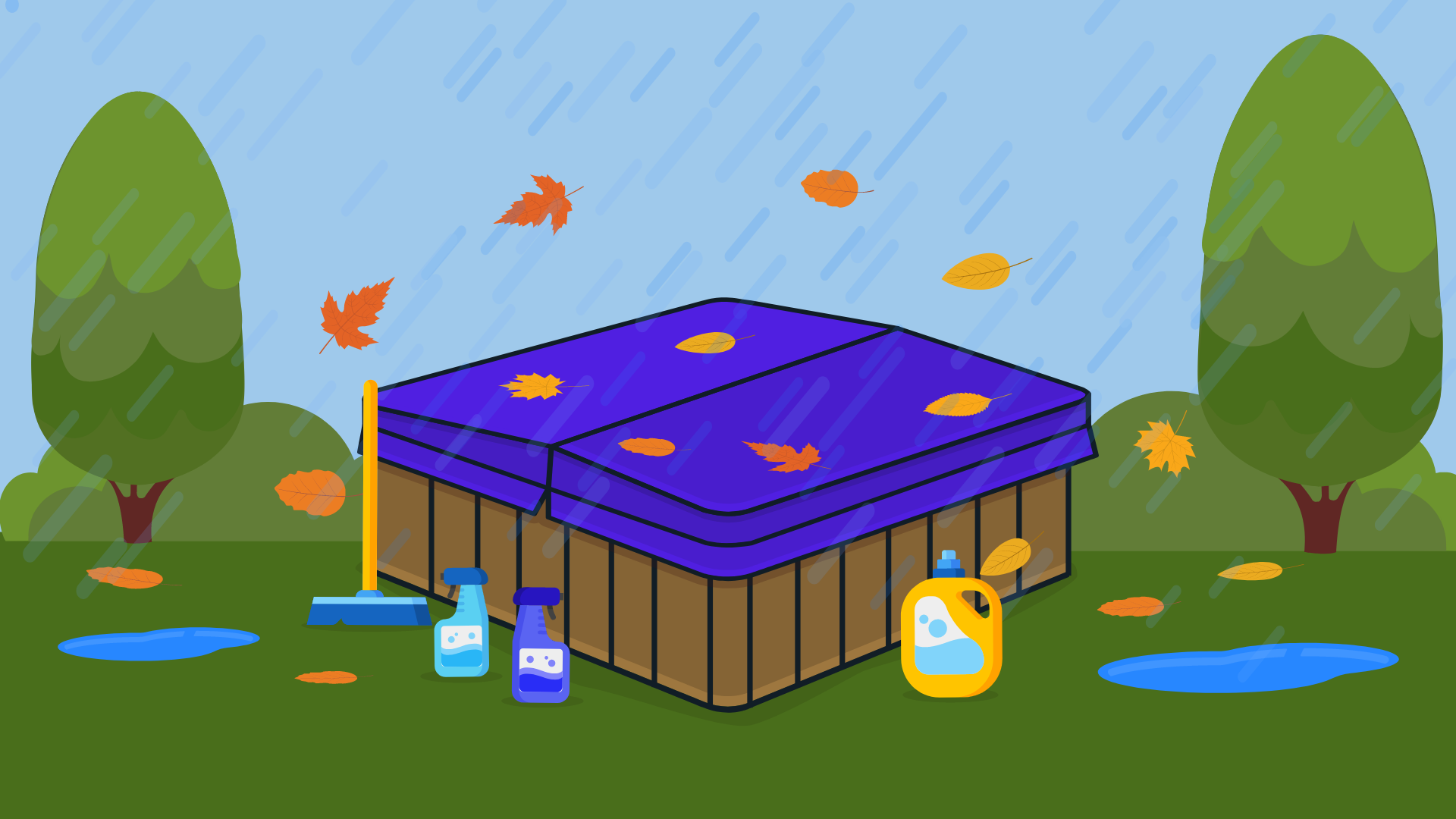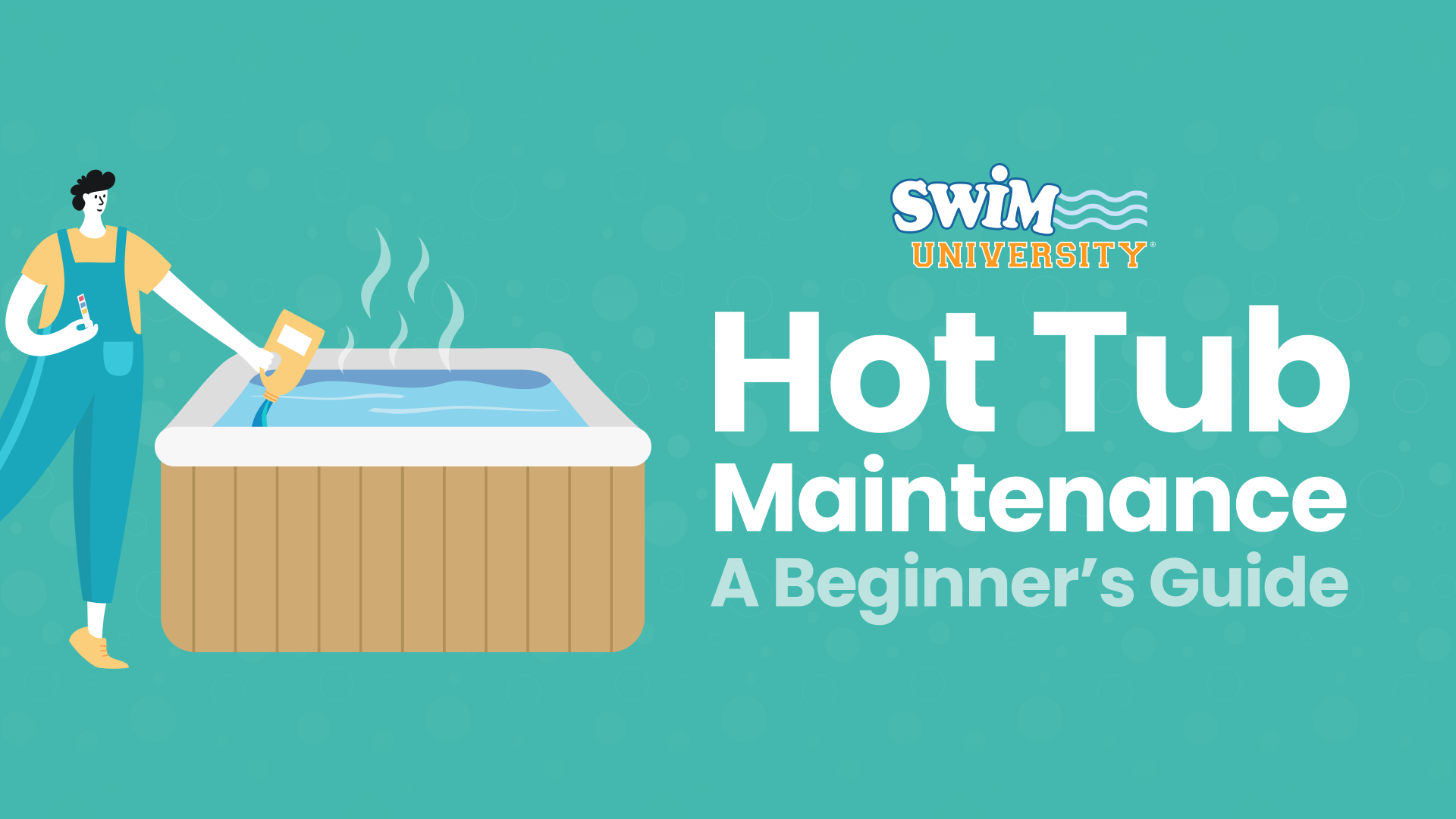25 Awesome Hot Tub Care Tips and Tricks
We all love the fun parts of owning a hot tub—relaxing, reading, testing out our theories about time travel. But along with all the good times comes a bit of necessary upkeep. Staying on top of hot tub care—like cleaning your spa, balancing the water chemistry, and making repairs—means your hot tub is ready for action when you are.
Happily, there’s no law that says you have to make hot tub maintenance any harder than it has to be. Tap into the wisdom of these tried and true tips, and you can tackle your hot tub chores more efficiently. You might save some time, money, and frustration too.
Learn how to keep your hot tub clear while saving money so you can enjoy more soaking time without big costs. The Hot Tub Handbook covers every type of hot tub on earth.
Hot Tub Care Tips to Make Your Life Easier
No matter what kind of hot tub chore is on your list, you can bet there’s a way to make it faster, more effective, less expensive, or all three!
1. Use Pantyhose for Cleaner Flows
Maintaining balanced chemistry in a body of water as small as your hot tub means you’ll be changing the water frequently. You can keep recirculated dirt and debris from getting into your filter system by covering the lower return inlets with pantyhose when you change the water.
Keeping that gunk out of your filter system reduces the stress on your spa’s system and helps keep it working longer. Cleaner water also means you’ll have a leg up (heh) on balancing water chemistry, too.
2. Tennis Balls Backhand Dirt and Grime
Want to keep body oils, hair products, lotions, and other goop from entering your spa’s filter? Drop a few tennis balls into your spa’s skimmers, or even directly into the water.
Your fuzzy, yellow friends will soak up the bad stuff in their fibers and make it easier to keep your spa looking, and feeling, clean and healthy. For best results, change them regularly, especially if you use your tub frequently or have a lot of people using the tub at once.
3. Build Your Own Siphon Vacuum
When hot tub DIY meets TLC, the result is much more than an improperly formatted Roman numeral. You can vacuum grit, gunk, and small debris from your spa with ease once you’ve put together this simple siphon vacuum.
You’ll need a few basic items to begin:
- 3 ft. (.91 m) of ¾ in. (1.9 cm) schedule 40 PVC pipe
- 6 ft. (1.8 m) of garden hose, with a female adapter on one end
- ¾ in. (1.9 cm) male threaded adapter (MTA), glued to one end of the PVC
- Assemble your vacuum by screwing the female hose end into the MTA on the pipe.
- To get your siphon flowing, prime the hose by submerging it in water.
- Cap the hose’s free end, then drop it to the ground. Water will start flowing immediately. The water will continue to flow as long as the hose’s free end is below the spa’s water level.
- Move the pipe around the bottom of your hot tub to vacuum.
4. Keep Your hot tub cover Fresh with Bleach
One of the most overlooked areas of proper hot tub care is treating your hot tub cover right. Exposed as they are to constant heat and moisture, hot tub covers can develop a musty or mildewy smell if they’re not cleaned properly.
You can keep the funk away by using a simple bleach solution to clean your hot tub cover. In a spray bottle, combine nine parts water to one part bleach, and use it to clean the underside of your hot tub cover every 90 days.
Bleach with 7.5% sodium hypochlorite offers powerful sanitizing capabilities.
5. Make Time for Enzymes
You might know them best from chemistry class, but enzymes aren’t just handy for processing food or making wine. These twisty little proteins get around to the strangest places—including your hot tub.
Special enzyme products for your spa work the same way most other enzymes do: they break down organic compounds. In your hot tub, they break down fatty lipids from body oils, cosmetics, lotions, and other sources that might be lurking in your water.
Dosed with enzymes, your hot tub and filter system will be cleaner, and your sanitizer will work more efficiently. Enzymes also keep your spa free of the “scum line” that can sometimes form at the water’s edge.
6. Track Your Time to Avoid a (Re)filling Disaster
Make sure you set a timer when you’re filling or refilling your hot tub. It can be all too easy to walk away and get caught up in other chores.
The result? Potential overflows, a huge mess, and even fried equipment. A little preparation sure beats having to magically bail out your spa enclosure.
This versatile kitchen timer features a loud ringing alarm, large clear LCD digits, and a memory function for both count-up and count-down operations, offering a magnetic back, retractable stand, and hook for hanging.
7. Get a Healthy Flow with a Hose Filter
Maintaining your spa’s water chemistry can be tricky. You can make it a little easier by starting with the cleanest water possible.
When you’re filling up your hot tub, attach a hose filter to the hose. If you don’t have one, place the hose in your spa’s filter area so the incoming water will pass through the filter.
Fill your pool or hot tub with this hose filter that'll filter your water so you can have a fresh start with water chemistry.
8. Clean Your Filter Cartridges with a Spray Cleaner
The secret to truly clean hot tub filters is frequent washing. Aside from a weekly rinse and a quarterly soak, you can keep your filters in tip-top shape by giving them a thorough once-over with a spray cleaner once a month.
If you don’t have any spray cleaner handy, you can dilute your favorite hot tub filter cleaner according to the package directions and add it to your own spray bottle. Be sure to give the filter a good drenching with the cleaner, and rinse well to avoid the dreaded foam in your hot tub.
Soak your hot tub filters in this deep-cleaning solution, rinse with water, and your filters will look brand new in 24 hours!
9. Baby Got Back…up Filters
Sometimes, hot tub care is about hoping for the best, but planning for the worst.
With proper care, your spa filters can have a long and healthy lifespan. But nothing lasts forever, and Murphy’s Law is always hiding in the tall grass.
Always keep an extra filter cartridge on hand, just in case. If your filter flakes, you can swap in your spare and keep the hot tub fun rolling without missing a beat.
This easy-to-clean pool filter cartridge captures tiny dirt particles and debris to keep your water crystal clear. It fits many popular hot tub models and only needs monthly cleaning.
10. Find Hidden Surface Issues with Dish Soap
Draining and refilling your spa is hard work that you’re probably not thrilled to take on unless absolutely necessary. So if you’re trying to track down interior surface problems in your spa such as texture issues, cracks, etc., but don’t want to drain the whole works to do so, make a run to your kitchen sink.
A squirt or two of dish soap will help break ripples on the water’s surface, giving you a clearer view of what’s going on beneath.
11. It’s a Baking Soda Party—And You’re Invited
Note: This tip applies to hot tubs with tile.
If your hot tub has tiles, you’ve got an additional item on your hot tub care checklist: grout. To keep it looking its best, follow a few easy steps.
- Mix baking soda and water together in a bowl to form a thick paste.
- Apply the paste to your tiles and grout with a damp sponge.
- After five minutes, turn on the hot tub.
- Grab an old toothbrush, climb into the tub, and attack those grout lines with a circular scrubbing motion.
The baking soda should have a negligible effect on your spa’s water chemistry, but be sure to check and balance it as necessary when you’re finished.
You can tackle a little bit of your grout at a time, or, better yet, bribe a bunch of friends with free food and drink and host a scrubbing party. (You might want to make the bribe a substantial one if you plan on keeping them as friends.)
No baking soda in the cupboard? Use white vinegar.
An affordable alternative to traditional chemicals, baking soda will naturally raise the alkalinity and pH in your water. It's also useful for cleaning tiles and surfaces.
12. Try Partial Water Changes
One of the most important factors in deciding when to change your hot tub water is the level of Total Dissolved Solids (TDS)—a measure of everything soluble in your spa’s water. High TDS levels can indicate organic contamination and other problems. You can avoid doing full water changes by taking a page from aquarium enthusiasts and performing partial water changes at more frequent intervals than you would full ones.
Rather than emptying your tub completely, remove a portion of your spa’s water, check the levels with a TDS meter, and adjust as necessary until your water is balanced and healthy. Low TDS levels make balancing your water chemistry much easier and help your sanitizers work more efficiently.
Partial water changes are especially helpful in cold climates, where a full water change might not always be practical due to inclement weather or extreme temperatures.
You can—and should—still perform full changes on a regular schedule as part of your standard hot tub care, but partial changes can be handy when you want to use your hot tub quickly and safely.
13. Cool Your Spending with Off-Peak Heating
You can save a pretty sweet chunk of change by running your hot tub’s heater during off-peak hours, or the hours of lowest demand. Not sure when that might be? Check with your utility provider for details.
And if you haven’t already, insulate your hot tub. Efficient insulation, combined with heating during off-peak hours, can cut your energy costs. It’ll also reduce the stress on your hot tub’s system and help your hardware last longer.
14. Keep Your Jets Clear with White Vinegar
If you’re dealing with hard water as part of your regular hot tub care routine, you already know calcium can accumulate in your jets and cause them to stiffen, clog, or stop working altogether.
To help combat the build-up, grab some white vinegar and clean your spa’s valves and jets. The acidic power of the vinegar will dissolve the calcium and get things flowing again. Be sure to rebalance your water chemistry after cleaning, since acids affect hot tub pH and alkalinity levels.
All-natural and diluted to a cleaning strength of 30% acidity.
15. Give Your Spa Room to Breathe
When ambient temperatures soar, your hot tub’s temperature can creep upward to uncomfortable levels. You can help cool things off by placing a pair of tennis balls between the acrylic shell and your hot tub cover at night.
Opening things up a bit allows cooler night air to reach your water and help keep the water temperature down.
You can also leave your hot tub cover open for 15 minutes or so after adding chemicals to let your spa release any lingering, potentially corrosive, gases. A quick breather can help protect your pillows, plastic parts, and cover from damage.
Finally, an Easy Way to Read Your Water Temperature from Both Indoors and Outdoors
16. Keep Your Spa Covered
Just like a jar of mayo, your hot tub will stay healthier if you keep the lid on it when you’re not using it. The cover helps your hot tub maintain a constant temperature, and keeps out bugs, frogs, and other invaders. If you use bromine to sanitize your hot tub, your cover can boost the bromine’s performance, too.
Bromine is powerful and keeps more of its sanitizing power at high temperatures than chlorine. But like chlorine, bromine can be broken up by UV light, so keeping your hot tub covered whenever you’re not using it will help extend the life of your sanitizer.
This premium hot tub cover, made of thick, marine-grade vinyl and with a weather-resistant design, keeps your spa safe from damage and helps you save money on heating costs.
17. When In Doubt, Drain and Refill
You probably spend a lot of time and effort monitoring and adjusting your hot tub water chemistry. But sometimes a tweak can’t bring things back into balance.
Instead of wasting a lot of time and money dumping expensive chemicals into your hot tub, you can often solve tricky water problems with one step: drain and clean your hot tub.
You’ll spend far less on water and chemicals with a refill than you will tinkering and tweaking an out-of-whack spa. You’ll also help the environment, since you’ll use less water and fewer chemicals to balance it.
18. Use Double Covers to Save Money
Protect your spa’s water from moisture, unwanted chemicals, and the animal kingdom by using both a floating hot tub cover and a regular hard top cover.
You’ll keep out unwanted contaminants, and keep in your heat and chemicals. Your spa will be more energy efficient, lowering your energy and supply costs.
A great cover to help keep the water warm. Using it regularly also helps maintain your water chemistry levels. Our solar blanket covers are made from a lightweight, yet durable polyethylene material. They are easy to install by cutting the cover to the shape of your spa or hot tub with scissors if it is irregularly shaped.
19. Don’t Use Pool Chemicals
They might seem similar, but using the same chemicals in your hot tub as you do in your pool can also be a costly mistake.
Why? A few reasons:
Trichlor tablets are quite acidic and concentrated for treating large areas of water. The acidity will lead to a quick decline in pH in your hot tub.
Soda ash for your pool can cause water balance issues if you use it in a hot tub. Its high pH has a strong effect on a small body of water like your spa.
Muriatic acid can also cause water chemistry problems. Your best bets are alkalinity and pH products made for hot tubs.
Liquid chlorine has one pound of salt for every gallon of chlorine. When you add that to a hot tub, the total alkalinity, pH, and calcium hardness will skyrocket.
Stick to hot tub chemicals for your hot tub, and you’ll get much better results.
20. Close Air Control Valves When Not in Use
After you’ve enjoyed a nice soak in your hot tub, make sure you close the air control valves. These knobs on top of the hot tub allow air to mix with the water coming out of your jets.
Since these valves let cold air into the water, your hot tub will take much longer to heat if they remain open during the heating cycle. A quick twist now lets you heat things up more quickly the next time you use your spa.
21. Keep Oil and Soap Products Out of Your Spa
The human body is a goldmine of potential hot tub contaminants. Hair products, deodorant, sunscreen, skin creams, and other products will cloud the waters fast. Sweat, dead skin, excess soap, or lingering fabric dyes can also cause problems. When contaminants come to call, cloudy, dirty water and a clogged filter are the inevitable result.
Prevention is the best medicine. Have your friends and family shower before they enter your spa to keep their lotions and potions from clogging up the works.
And when you clean your hot tub, avoid soap or ammonia-based degreasers, since they can linger and wreak havoc on your water chemistry.
22. Keep Baseball Caps Near Your Hot Tub
A quick game of catch is fun, but the real reason to keep some clean baseball caps near your hot tub is to keep hair out of your spa. Folks with long hair can tuck it up under the cap to keep it from getting into the water.
Not only will this keep hair out of your water, but also the sprays, gels, and other products that might gum up the works.
23. Test Your Hot Tub Water on the Regular
Balanced hot tub water is essential to a safe and happy soak. And the best way to make sure everything’s ship-shape is to test your hot tub water regularly.
How regularly? It depends on your region, the weather, and how often you use your spa. A good rule of thumb is four to five times a week—and a good quality test kit is vital to provide safe water for your friends and loved ones.
This complete water testing kit helps keep your pool or hot tub clean and safe to swim in, with easy-to-follow color instructions and all the supplies you need in one box.
24. Use Extra Caution When Adding Chemicals
A small body of water like your hot tub is sensitive to chemical changes. Adding too much of anything can cause major shifts in chemistry.
Measure twice, add once. Be sure to follow the instructions on the package, and measure all your chemicals based on the volume of water in the hot tub to prevent equipment or skin damage.
Be especially careful with high acid levels. They’re not only dangerous to people, but can cost you big by corroding and destroying your hardware.
25. Keep Your Hot Tub From Freezing
If you live where the temperature drops below 32°F (0°C), we recommend keeping your hot tub filled with water and running at normal temperatures at all times.
If that’s not possible, you can also winterize your hot tub to protect it from freeze damage.
For emergency situations, such as equipment failure, you can place a small space heater in the equipment area to keep things from freezing up until you can make repairs. Make sure you keep the heater away from plumbing lines.
Your Hot Tub Never Had It So Good
Dealing with hot tub care doesn’t have to leave you feeling like a rank amateur. The key is to keep up with maintenance. The longer you let things go, the more difficult it will be to correct water chemistry and other potential problems.
Your hot tub will be in the best shape of its life, and you can focus your energy on more important things, like enjoying your spa, and maybe perfecting that time-travel module.
Happy Soaking!
3 More Ways We Can Help With Your Hot Tub
- Hot Tub Cheat Sheets (Free): Easy-to-use guides to help you keep your hot tub water balanced and sanitized.
- The Hot Tub Handbook: An illustrated guide to DIY hot tub care, including water chemistry, maintenance, troubleshooting, and more.
- The Hot Tub Care Course. You’ll get step-by-step videos and a step-by-step downloadable guide with everything you need to know about hot tub maintenance.
